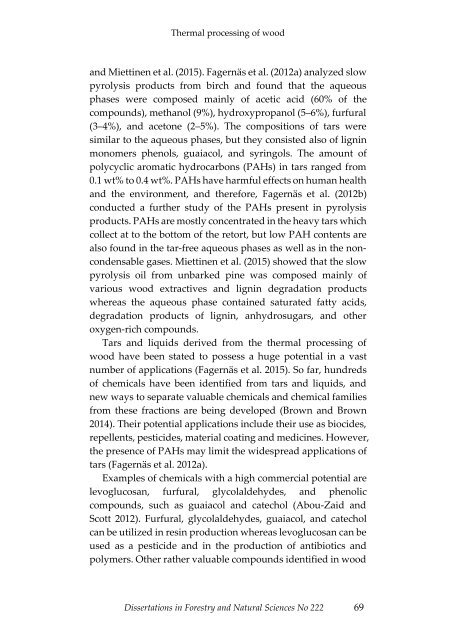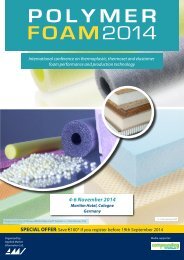Dissertations in Forestry and Natural Sciences
24lYKFN
24lYKFN
You also want an ePaper? Increase the reach of your titles
YUMPU automatically turns print PDFs into web optimized ePapers that Google loves.
Thermal process<strong>in</strong>g of wood<br />
<strong>and</strong> Miett<strong>in</strong>en et al. (2015). Fagernäs et al. (2012a) analyzed slow<br />
pyrolysis products from birch <strong>and</strong> found that the aqueous<br />
phases were composed ma<strong>in</strong>ly of acetic acid (60% of the<br />
compounds), methanol (9%), hydroxypropanol (5–6%), furfural<br />
(3–4%), <strong>and</strong> acetone (2–5%). The compositions of tars were<br />
similar to the aqueous phases, but they consisted also of lign<strong>in</strong><br />
monomers phenols, guaiacol, <strong>and</strong> syr<strong>in</strong>gols. The amount of<br />
polycyclic aromatic hydrocarbons (PAHs) <strong>in</strong> tars ranged from<br />
0.1 wt% to 0.4 wt%. PAHs have harmful effects on human health<br />
<strong>and</strong> the environment, <strong>and</strong> therefore, Fagernäs et al. (2012b)<br />
conducted a further study of the PAHs present <strong>in</strong> pyrolysis<br />
products. PAHs are mostly concentrated <strong>in</strong> the heavy tars which<br />
collect at to the bottom of the retort, but low PAH contents are<br />
also found <strong>in</strong> the tar-free aqueous phases as well as <strong>in</strong> the noncondensable<br />
gases. Miett<strong>in</strong>en et al. (2015) showed that the slow<br />
pyrolysis oil from unbarked p<strong>in</strong>e was composed ma<strong>in</strong>ly of<br />
various wood extractives <strong>and</strong> lign<strong>in</strong> degradation products<br />
whereas the aqueous phase conta<strong>in</strong>ed saturated fatty acids,<br />
degradation products of lign<strong>in</strong>, anhydrosugars, <strong>and</strong> other<br />
oxygen-rich compounds.<br />
Tars <strong>and</strong> liquids derived from the thermal process<strong>in</strong>g of<br />
wood have been stated to possess a huge potential <strong>in</strong> a vast<br />
number of applications (Fagernäs et al. 2015). So far, hundreds<br />
of chemicals have been identified from tars <strong>and</strong> liquids, <strong>and</strong><br />
new ways to separate valuable chemicals <strong>and</strong> chemical families<br />
from these fractions are be<strong>in</strong>g developed (Brown <strong>and</strong> Brown<br />
2014). Their potential applications <strong>in</strong>clude their use as biocides,<br />
repellents, pesticides, material coat<strong>in</strong>g <strong>and</strong> medic<strong>in</strong>es. However,<br />
the presence of PAHs may limit the widespread applications of<br />
tars (Fagernäs et al. 2012a).<br />
Examples of chemicals with a high commercial potential are<br />
levoglucosan, furfural, glycolaldehydes, <strong>and</strong> phenolic<br />
compounds, such as guaiacol <strong>and</strong> catechol (Abou-Zaid <strong>and</strong><br />
Scott 2012). Furfural, glycolaldehydes, guaiacol, <strong>and</strong> catechol<br />
can be utilized <strong>in</strong> res<strong>in</strong> production whereas levoglucosan can be<br />
used as a pesticide <strong>and</strong> <strong>in</strong> the production of antibiotics <strong>and</strong><br />
polymers. Other rather valuable compounds identified <strong>in</strong> wood<br />
<strong>Dissertations</strong> <strong>in</strong> <strong>Forestry</strong> <strong>and</strong> <strong>Natural</strong> <strong>Sciences</strong> No 222 69



